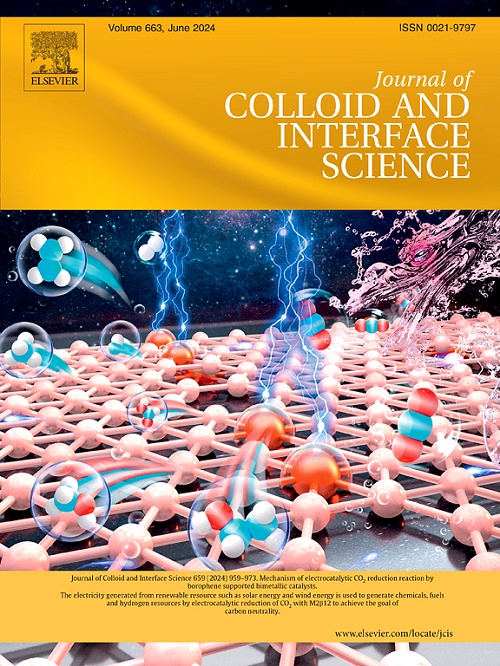Sacrificial-free H2O2 photosynthesis on organic-inorganic core–shell heterojunction under visible light irradiation
IF 9.4
1区 化学
Q1 CHEMISTRY, PHYSICAL
引用次数: 0
Abstract
Artificial photosynthesis is a promising way to change light energy into chemical energy stored in hydrogen peroxide (H2O2). However, numerous heterojunction-based photocatalytic systems have substantially restricted effective H2O2 generation due to the intrinsic tendency toward fast charge recombination and the deficiency in active site population on the catalyst surface, especially under conditions not employing sacrificial agents. This study in situ prepared ZnIn2S4 (ZIS) nanoflowers onto a hollow covalent organic framework to strategically engineer a type-II organic–inorganic core–shell heterojunction photocatalyst, transforming O2 into H2O2. The heterojunction photocatalyst exhibited an exceptional H2O2 productivity of 3334 μmol g−1h−1 when no sacrificial agent was added, surpassing most reported systems. Mechanistic studies revealed that the heterojunctions extended the light absorption spectrum toward longer wavelengths and significantly increased the probability of electron transfer from photogenerated carriers to reactive species, which accelerated the reduction of O2 to H2O2. Furthermore, theoretical calculations confirmed that the heterojunction formation modified the coordination environment of the active sites on ZIS, fine-tuned the binding interaction between O2 and the catalyst interface, and reduced the energy barrier of intermediates, leading to superior performance. This study designed a novel, highly efficient organic–inorganic core–shell heterojunction photocatalyst and provided a promising strategy for enhancing the O2-to-H2O2 conversion.

可见光照射下有机-无机核壳异质结的无牺牲H2O2光合作用
人工光合作用是一种很有前途的将光能转化为储存在过氧化氢(H2O2)中的化学能的方法。然而,许多基于异质结的光催化体系由于固有的快速电荷重组倾向和催化剂表面活性位点数量的缺乏,特别是在不使用牺牲剂的条件下,极大地限制了有效的H2O2生成。本研究在空心共价有机骨架上原位制备ZnIn2S4 (ZIS)纳米花,策略性地设计了ii型有机-无机核-壳异质结光催化剂,将O2转化为H2O2。在不添加牺牲剂的情况下,异质结光催化剂的H2O2产率达到3334 μmol g−1h−1,超过了大多数报道的体系。机制研究表明,异质结使光吸收光谱向更长的波长延伸,并显著增加了电子从光生载流子向活性物质转移的概率,从而加速了O2还原为H2O2的过程。此外,理论计算证实,异质结的形成改变了ZIS上活性位点的配位环境,微调了O2与催化剂界面之间的结合相互作用,降低了中间体的能垒,从而获得了优异的性能。本研究设计了一种新型、高效的有机-无机核壳异质结光催化剂,为提高o2 - h2o2转化提供了一种有希望的策略。
本文章由计算机程序翻译,如有差异,请以英文原文为准。
求助全文
约1分钟内获得全文
求助全文
来源期刊
CiteScore
16.10
自引率
7.10%
发文量
2568
审稿时长
2 months
期刊介绍:
The Journal of Colloid and Interface Science publishes original research findings on the fundamental principles of colloid and interface science, as well as innovative applications in various fields. The criteria for publication include impact, quality, novelty, and originality.
Emphasis:
The journal emphasizes fundamental scientific innovation within the following categories:
A.Colloidal Materials and Nanomaterials
B.Soft Colloidal and Self-Assembly Systems
C.Adsorption, Catalysis, and Electrochemistry
D.Interfacial Processes, Capillarity, and Wetting
E.Biomaterials and Nanomedicine
F.Energy Conversion and Storage, and Environmental Technologies

 求助内容:
求助内容: 应助结果提醒方式:
应助结果提醒方式:


